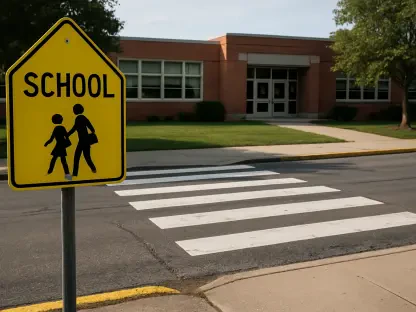In a remarkable step toward safeguarding communities from the ravages of natural disasters, Pennsylvania has unveiled a pioneering initiative that marries advanced weather monitoring technology with educational innovation at the Greencastle-Antrim School District (G-A Schools). This collaborative effort, involving key players like the Pennsylvania Emergency Management Agency (PEMA), Penn State University, and the National Weather Service (NWS), introduces the cutting-edge IFLOWS 2.0 system at G-A Middle School, designed to enhance flood warnings and weather data collection. The project not only aims to protect lives and property through precise forecasting but also seeks to inspire a new generation by embedding real-time weather data into school curricula. As flooding remains a critical threat in the state, this dual approach of bolstering safety infrastructure while fostering environmental literacy offers a promising model for resilience. The impact of such a comprehensive strategy reverberates across local communities, setting a benchmark for how technology and education can unite to confront pressing challenges posed by severe weather events.
Advancing Public Safety Through Technology
Cutting-Edge Weather Monitoring with IFLOWS 2.0
The cornerstone of Pennsylvania’s latest safety initiative lies in the deployment of the IFLOWS 2.0 system, a sophisticated flood warning and observation tool now operational at G-A Middle School. This advanced technology captures an extensive range of weather metrics, such as temperature, precipitation levels, wind speed, humidity, and even soil moisture, to provide forecasters with precise, real-time insights. These detailed data points are instrumental in predicting hazardous conditions like floods, droughts, or intense windstorms, enabling emergency managers to issue timely alerts. By enhancing the accuracy of weather predictions, IFLOWS 2.0 plays a pivotal role in minimizing the devastating impacts of natural disasters, ensuring that communities have the critical information needed to prepare and respond effectively. The system’s installation marks a significant upgrade from older models, reflecting a commitment to leveraging modern tools for public protection.
Beyond its immediate functionality, the IFLOWS 2.0 system represents a forward-thinking approach to disaster preparedness in a state frequently battered by flooding. Its ability to monitor multiple environmental factors simultaneously offers a comprehensive picture of emerging weather threats, which is vital for small towns and rural areas often hardest hit by such events. The data collected feeds directly into broader forecasting networks, amplifying its reach and utility for emergency planning at both local and state levels. Supported by substantial funding, including a FEMA grant covering a significant portion of the costs, this initiative underscores the priority placed on safeguarding vulnerable populations. As a result, Pennsylvania is better equipped to anticipate and mitigate the risks posed by unpredictable weather patterns, potentially saving countless lives and reducing property damage in the process.
Expanding Coverage Through the Keystone Mesonet
A crucial element bolstering the effectiveness of IFLOWS 2.0 is the Keystone Mesonet, a statewide network that integrates weather data from hundreds of stations, including new setups at schools and along major highways like I-81. This collaborative framework, supported by a coalition of state agencies such as PEMA and PennDOT alongside academic contributions from Penn State, ensures extensive geographic coverage. The mesonet synthesizes information from diverse sources to create a unified, real-time picture of weather conditions across Pennsylvania, which is essential for rapid response during severe events. Such a robust system allows for more accurate predictions and coordinated emergency efforts, particularly in regions prone to sudden flooding or other natural hazards, strengthening the state’s overall disaster resilience.
The Keystone Mesonet’s impact extends beyond mere data collection, as it fosters synergy among various stakeholders dedicated to public safety. By linking stations at educational institutions with those managed by transportation and environmental agencies, the network ensures that no corner of the state is left unmonitored. This interconnected approach enhances the ability to detect early warning signs of dangerous weather, facilitating proactive measures that can prevent loss of life and infrastructure damage. The collaborative spirit driving the mesonet’s expansion reflects a shared understanding that comprehensive weather monitoring is a collective responsibility, one that benefits every resident. As more stations join this network, Pennsylvania solidifies its position as a leader in innovative disaster preparedness strategies.
Revolutionizing Education with Weather-Based Learning
Integrating Real-Time Data into K-12 Curriculum
One of the most innovative facets of this initiative is the development of a K-12 weather curriculum, crafted through a partnership between G-A Schools and Penn State’s Department of Meteorology and Atmospheric Science. This educational program, aligned with state academic standards, incorporates live data from IFLOWS 2.0 and other monitoring networks directly into STEM lessons. Students across various grade levels engage with real-time weather metrics to study patterns, track storms, and analyze climate trends, mirroring the analytical processes of professional meteorologists. This hands-on approach transforms abstract concepts into tangible learning experiences, equipping young minds with practical skills while deepening their grasp of scientific principles. Such integration not only enriches classroom instruction but also bridges the gap between theoretical knowledge and real-world application.
The curriculum’s design emphasizes accessibility and relevance, ensuring that students from elementary to high school levels can participate in meaningful ways. By utilizing the same data streams that inform emergency weather alerts, the program offers a unique window into the critical role of meteorology in public safety. Teachers are provided with resources to guide pupils through experiments and projects, such as predicting local weather events or understanding the impact of humidity on precipitation. This initiative stands out for its ability to make complex science relatable, fostering curiosity and critical thinking among students. As a result, the educational system in Pennsylvania is poised to cultivate a generation well-versed in environmental dynamics, ready to tackle future challenges with informed perspectives.
Fostering Environmental Literacy and Community Impact
Beyond academic enrichment, the weather-focused curriculum aims to instill a profound sense of environmental stewardship in students, encouraging them to see themselves as active contributors to their communities. By engaging with live data used by professionals, young learners develop a nuanced understanding of the weather-related challenges that affect their surroundings, particularly in a state where flooding poses a persistent threat. This educational approach aligns closely with Penn State’s mission to serve the public good, emphasizing the importance of informed citizenship and sustainable practices. Students are not merely passive recipients of information but are empowered to think critically about how environmental factors shape daily life and long-term community resilience.
The broader community impact of this initiative cannot be overstated, as it creates a ripple effect of awareness and preparedness starting from the classroom. Students trained in weather analysis can share insights with family and peers, amplifying the reach of safety knowledge within their neighborhoods. This educational model also prepares future leaders to address climate and weather challenges with a blend of scientific acumen and civic responsibility. By embedding such learning opportunities in schools, Pennsylvania is investing in a culture of proactive environmental engagement, ensuring that the next generation is equipped to advocate for and implement solutions to natural hazards. This focus on literacy and impact underscores the transformative potential of combining education with real-world data application.
Collaborative Efforts for a Resilient Future
Uniting Diverse Stakeholders for a Common Goal
The success of Pennsylvania’s weather safety and education initiative hinges on the unprecedented collaboration among a wide array of stakeholders, including PEMA, NWS, Penn State, and state departments like PennDOT and the Department of Environmental Protection. This coalition has pooled resources and expertise to enhance the state’s weather monitoring infrastructure, with significant financial backing from a FEMA grant that offsets the majority of costs for new station installations. Each entity brings unique strengths to the table, from emergency management know-how to academic research capabilities, creating a unified front dedicated to protecting lives and property. This teamwork exemplifies a shared commitment to addressing the urgent threat of natural disasters through innovative and coordinated efforts.
The collaborative framework ensures that the initiative is not a fragmented effort but a cohesive strategy with far-reaching benefits. Agencies responsible for infrastructure and transportation work alongside educational institutions to integrate weather data into both practical safety measures and learning environments. This synergy maximizes the utility of systems like IFLOWS 2.0 and the Keystone Mesonet, ensuring that data serves multiple purposes, from issuing flood alerts to enriching student projects. The dedication of these diverse partners highlights a collective recognition of the stakes involved in weather preparedness, particularly in a state with a history of severe flooding. Their combined efforts lay a strong foundation for sustained improvements in disaster response and community education.
Building a Model for Statewide Impact
Reflecting on the strides made, this partnership between educational, governmental, and scientific bodies establishes a powerful precedent for addressing societal challenges through integrated solutions. The deployment of monitoring systems at multiple schools and the planned expansion of the network demonstrate a scalable approach to enhancing safety across Pennsylvania. This model not only fortifies immediate community resilience but also offers a replicable blueprint for other regions grappling with similar weather threats. The fusion of technology and curriculum development showcases how multifaceted strategies can yield comprehensive benefits, from immediate disaster prevention to long-term educational gains.
Looking ahead, the focus shifts to sustaining and broadening this initiative’s reach, with plans to install additional weather stations and refine the K-12 curriculum based on feedback and evolving needs. Stakeholders aim to deepen public awareness of weather safety through community outreach tied to student learning outcomes. The success of this endeavor suggests a future where every school could serve as a hub for both education and emergency preparedness, amplifying the state’s capacity to withstand natural hazards. This forward-thinking vision encourages ongoing investment in technology and partnerships, ensuring that Pennsylvania remains at the forefront of innovative disaster resilience for years to come.









